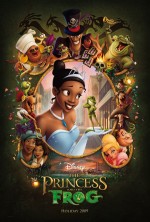Mr. Cameron Wants You to Be Comfortable While He Does His Thing
2009 // USA // James Cameron // December 22, 2009
// 3D Digital Theatrical Projection (AMC West Olive)
B+ - I was only one year old when Star Wars was released in 1977, which means that for all practical purposes, I've always lived in a post-Star Wars world. While I later participated quite enthusiastically in the broader consumer phenomenon often summed up as simply "Star Wars,"--encompassing sequels, toys, comics, and card games, to name just the few products I personally devoured--I was too young to catch Star Wars: A New Hope in its original theatrical release. Even if I had been a few years older at the time, I obviously wouldn't have been able to appreciate it as anything other than an entertaining tale of adventure. Accordingly, when older generations speak of the revolutionary nature of Star Wars as cinema, of how it blew their minds and opened up previously undreamed possibilities in terms of the places movies could take us, I've always nodded along without ever truly understanding what they were saying. How could I? Subsequent cinema has been irrecoverably altered--or tainted, depending on your point of view--by the existence of Star Wars and is phenomenal commercial success.
Perhaps the highest praise I can bestow on James Cameron's mind-bogglingly expensive 3D science-fiction epic, Avatar, is that I can now understand how my forebears felt when they first settled in to let Star Wars wash over them. There's nothing particularly nuanced about Avatar, which is essentially a standard science-fiction adventure, straight up, no chaser. Thematically, emotionally, and structurally, its ambitions are modest, even pedestrian. However, like Star Wars before it, Avatar is a revolutionary film. You've heard it a hundred times before, but this time is indisputably true: This Is Like Nothing I Have Ever Seen. It is fitting that it has been birthed by James Cameron, a technophilic film-maker whose finest works tell simple stories with relentless energy and discreet intelligence. It's a cliché to insist that a movie must be seen in the theaters to be appreciated, but Avatar is the first film in memory than positively demands that it be experienced in its full glory, and that means 3D digital theatrical projection. This is a film that will be a shadow of its former self on even the most elaborate home theater system. Trust me on this: cough up the funds for that overpriced multiplex ticket, and prepare to see a new world unfold before your eyes.
One element that sets Cameron's blockbuster science-fiction films--The Terminator, Aliens, The Abyss, and Terminator 2--apart from similar genre works is the extent to which the exposition necessary for all futurist stories is effortlessly integrated into the film, often via a vigorous blend of showing and telling. Despite his Master of the Universe reputation as a writer-director, Cameron has always been first and foremost a storyteller. The masturbatory pleasures of world-building for its own sake seem to have little attraction for him. His visions of the future are densely furnished with vivid technologies, but these are invariably placed into his films for the purpose of story, rather than "merely" to create a seamless setting. (This leads to the Cameron corollary to Chekov's gun: If more than a few seconds are spent depicting or describing a technology, that technology will play a crucial role in the plot before the credits roll.) To be sure, Cameron loves his world-building--witness the notorious tales of his fanatical attention to historical detail in Titanic--but in his science-fiction films the details always matter.
Avatar is no exception to this trend. One of the storytelling achievements of the film is the extent to which the director considerably ups the ante in terms of his setting's complexity, and still manages to convey all the information with speed and precision. Part of Avatar's futurist vision is indebted to elements that Cameron himself has previously presented, especially the hardened space marines and nefarious, planet-plundering corporation of Aliens. However, on top of the mechanized armor and slimy bureaucrats that have since become staples of space-based science-fiction films, Cameron adds a layer of New Age wonder. Avatar is set almost wholly on the lush moon of Pandora, where an interstellar mining company has established a colony to extract a rare, valuable mineral. Needless to say, this doesn't sit well with the planet's inhabitants: giant, lanky blue humanoids called Na'vi, who lead an Edenic hunter-gatherer existence in the moon's phosphorescent jungles. The Company employs both the carrot and the stick in its dealings with the Na'vi. The former approach is exemplified by Grace Augustine (Sigourney Weaver), a scientist who advocates a kind of benevolent paternalism towards the natives (complete with colonial schools for the young), and who is absorbed with the unique qualities of the Na'vi and their world. Grace's kinder, gentler brand of exploitation doesn't sit well with the colony's security officer, Colonel Miles Quaritch (Stephen Lang), who would just as soon burn the forest to the ground and exterminate the "savages" to the last.
To aid in her team's study of Pandora's ecology and the culture of the Navi, Grace has developed the extraordinary avatar technology. Na'vi genetic material is mixed with a dash of DNA from an "operator" trained in biology and anthropology, and the result is a vat-grown, mindless organism that looks for all the world like a Na'vi, but must be mentally "driven" by the operator from an MRI machine on steroids. The avatars make exploration of the moon much easier for humans, who would otherwise be asphyxiated by its atmosphere or easily gobbled up by the seemingly endless hostile animal species. For their part, the Na'vi seem to be wise to Grace's trick, even if they don't understand exactly how it is achieved, and they generally regard the avatars as mentally ill or demonically possessed members of their race.
Ah, but let me back up. This elaborate setting is conveyed to us through the eyes of Jake Sully (Sam Worthington), a paraplegic marine who happens to be the identical twin brother of an avatar operator who was recently killed. It seems that avatars are only usable by the operator who shares their genetic fingerprint. Since the Company has already sunk untold millions into growing Jake's brother's avatar, it reasons: why not recruit the crippled twin to come out to Pandora and give it a shot? Grace is acidly skeptical, since Jake has no training whatsoever, and his military background means that he is susceptible to Colonel Quaritch's influence. Indeed, Jake is almost immediately recruited by the Colonel to ferret out the weaknesses of the Na'vi and the colossal tree where they dwell, which just happens to stand on top of the richest mineral deposits on the moon.
Thus Cameron sets up a familiar story arc: a soldier comes to the frontier to help control or exterminate the natives, only to find his sympathies for them growing as he lives among them. In this case, Jake sees, hears, smells, and touches everything his avatar does, all from the relative safety of a remote laboratory. Call it Dances with Virtual Aliens, right down to the archetypes: the warrior-princess love interest, Neytiri (Zoe Saldana); the suspicious hothead, Tsu'tey (Laz Alonso); and the wise elders, Eytukan (Wed Studi) and Moat (CCH Pounder). Will Jake fall in love with the simple beauty of the Na'vi lifestyle and come to see the error of humanity's rapacious, world-despoiling ways? Is there any doubt? There's not a drop of originality to the bare bones story here, but that's not necessarily a flaw when the setting itself is the hook. (Star Wars, after all, was just a rejiggered The Hidden Fortress in space opera clothing.) Accusations of mush-headed liberal preachiness will no doubt be lobbed at Cameron with contemptuous abandon in the weeks to come, but such critics fail to appreciate the extent which ecological and cultural concerns can now serve a primarily narrative function, particularly in genre adventure film. Certainly, "It's Wrong to Indiscriminately Murder and Steal for Personal Gain" is not a bold moral declaration, any more than "There Is No Fate But What We Make" is a penetrating philosophical insight. What's the conclusion? Not that Cameron is indulging in infantile ethical messaging, but that his use of now-stock archetypes--the hero turned from indifference to sympathy by immersion in an unfamiliar culture; the insightful and unjustly sidelined scientist; the bloodthirsty military commander--is about economy of storytelling.
It's hard to conclude that Avatar's Shake-n'-Bake characterization is a sign of authorial laziness, when the film is elsewhere so manifestly a work of stunning imagination. Cameron doesn't want to waste his time or the viewer's. The purpose of the simplistic drama is to sweep us along and provide a point of entry for the film's entire raison d'être, which is, quite simply, to show us jaw-dropping vistas that do not exist. It's pure escapism, but the purity of it is luxurious and downright searing. Almost everything in Avatar is apparently computer-generated, save the actors playing human characters and select props and set components. Yet the film lacks the aura of cheerless sterility that has characterized effects-heavy science fiction and fantasy films for nearly two decades now. Nothing about Avatar feels slipshod. Every drop of water, every hair, and every glowing mushroom is so carefully crafted with an eye towards the visual whole that the result never feels crafted at all. It is a marvelously convincing film, not only in the sense that it is easy to suspend one's sense of disbelief, but that it is so easy to forget that one is essentially watching an animated film with some live-action elements. The 3D projection serves to heighten the illusion, convincing us that we what are seeing is not a fiction fashioned of images and sound, but rather a window beyond which fantastic events are taking place. It is in all respects a dazzlingly immersive experience.
I shall resist cataloging the film's marvels, if only because a mere description cannot adequately convey the effect of seeing them. That's a trite statement, perhaps, but it's never felt more accurate than as applied to this film. I could describe the floating mountains clad in tropical greenery and wisps cloud, but it's no substitute for seeing them for yourself, preferably while soaring between them in digital 3D. One facet of the film's setting that deserves particular praise is the alien biology of Pandora, which boasts a level of conceptual innovation that science-fiction film has not exhibited in a generation. The plants glow with an eerie luminescence and respond to physical contact with movement and pulses of color. The air swarms with buzzing insects and floating seed pods. The species that lurch, stalk, slither, and soar through the jungles are all unique, yet they also are all manifestly the inhabitants of the same world. Most of the moon's megafauna bear a stalked, flower-like organ, as do the Na'vi themselves. By linking together the tips of their organs with those of the various animals, the Na'vi can telepathically control them. The level of thought that went into this conceit, from both a design and a narrative perspective, puts most genre films to shame.
Budget isn't everything. Most great films like, say, The Third Man, Taxi Driver, or No Country For Old Men, would not have been demonstrably improved had another $100 million been spent on them. Yet Avatar achieves success because of the confluence of three factors: the staggering imagination of James Cameron, the technology to create any thing or place he can conceive, and the budget to make it happen. Every dollar of Avatar's absurd $300+ million price tag is visible. It's less a movie than an art project that whisks us to a place far, far away. And there's a majesty in that, however warmed-over the story, however familiar the tropes, however corny the dialog. It's what "going to the movies" was all about, once upon a time.









